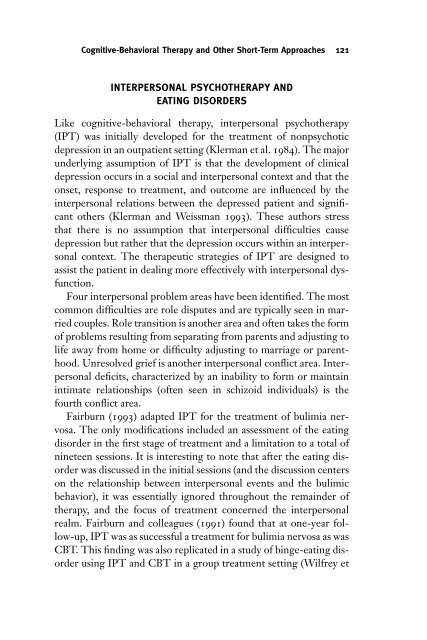Eating Disorders - fieldi
Eating Disorders - fieldi
Eating Disorders - fieldi
Create successful ePaper yourself
Turn your PDF publications into a flip-book with our unique Google optimized e-Paper software.
Cognitive-Behavioral Therapy and Other Short-Term Approaches 121<br />
INTERPERSONAL PSYCHOTHERAPY AND<br />
EATING DISORDERS<br />
Like cognitive-behavioral therapy, interpersonal psychotherapy<br />
(IPT) was initially developed for the treatment of nonpsychotic<br />
depression in an outpatient setting (Klerman et al. 1984). The major<br />
underlying assumption of IPT is that the development of clinical<br />
depression occurs in a social and interpersonal context and that the<br />
onset, response to treatment, and outcome are influenced by the<br />
interpersonal relations between the depressed patient and significant<br />
others (Klerman and Weissman 1993). These authors stress<br />
that there is no assumption that interpersonal difficulties cause<br />
depression but rather that the depression occurs within an interpersonal<br />
context. The therapeutic strategies of IPT are designed to<br />
assist the patient in dealing more effectively with interpersonal dysfunction.<br />
Four interpersonal problem areas have been identified. The most<br />
common difficulties are role disputes and are typically seen in married<br />
couples. Role transition is another area and often takes the form<br />
of problems resulting from separating from parents and adjusting to<br />
life away from home or difficulty adjusting to marriage or parenthood.<br />
Unresolved grief is another interpersonal conflict area. Interpersonal<br />
deficits, characterized by an inability to form or maintain<br />
intimate relationships (often seen in schizoid individuals) is the<br />
fourth conflict area.<br />
Fairburn (1993) adapted IPT for the treatment of bulimia nervosa.<br />
The only modifications included an assessment of the eating<br />
disorder in the first stage of treatment and a limitation to a total of<br />
nineteen sessions. It is interesting to note that after the eating disorder<br />
was discussed in the initial sessions (and the discussion centers<br />
on the relationship between interpersonal events and the bulimic<br />
behavior), it was essentially ignored throughout the remainder of<br />
therapy, and the focus of treatment concerned the interpersonal<br />
realm. Fairburn and colleagues (1991) found that at one-year follow-up,<br />
IPT was as successful a treatment for bulimia nervosa as was<br />
CBT. This finding was also replicated in a study of binge-eating disorder<br />
using IPT and CBT in a group treatment setting (Wilfrey et









